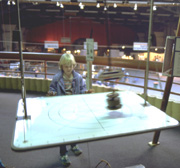


|
Mechanics/Dynamics/Motion
|
Relative Motion Pendulum
A
pendulum swings above a table. The table is also a pendulum that
swings at right angles to and has the same period as the first pendulum.
When both pendulums are set swinging at the same time, the observer
sees the relative motions of the two pendulums in the frame of reference
of the table. The relative motion can be linear, circular or elliptical
depending on the phases and amplitudes of the pendulums. The visitor
starts the pendulums swinging and controls their relative phase.
This exhibit makes Lissajous patterns mechanically.
This exhibit shows how two sinusoidal motions at right angles add
together. It can be used to explain polarization of light which
can be linear, elliptical or circular and which can be considered
as a combination of two components which are at right angles to
each other. It is very startling to hold a flat object next to the
first pendulum and to see that its motion is indeed back and forth
in a straight line when it looks like it is moving in a circle.
The visitor selects the symmetry of the patterns produced by the
pendulums by controlling the phase of the pendulums.
|

|

-
Birefringence
-
Composition of Perpendicular Motions
-
Conservation if Energy
-
Frames of Reference-Galelean
-
Kinetic Energy
-
Lissajous Figures
-
Natural Frequency
-
Pendular Motion
-
Periodic Motion
-
Polarization-Circular
-
Polarization-Linear
-
Potential Energy
-
Simple Harmonic Motion
-
Sinusoidal Waves
-
Symmetry






|